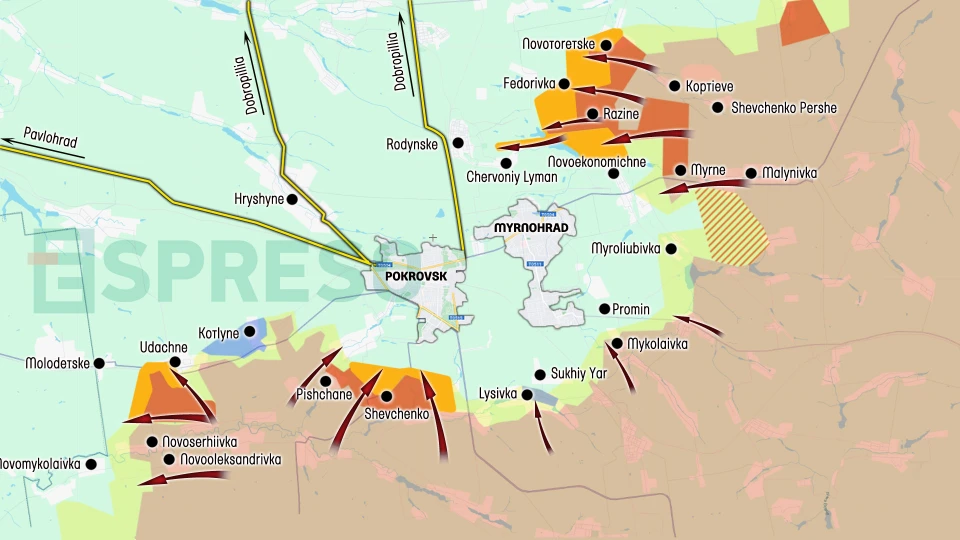Advancing on Pokrovsk will be major challenge for Russian forces, expert says
global.espreso.tv
Fri, 25 Jul 2025 21:30:00 +0300

Serhiy Zgurets, director of the media and consulting company Defense Express, said this on Espreso TV."Pokrovsk makes up about a 100 km stretch of the front line, out of a total length of 1,200–1,500 km, depending on how you measure it. It's located at a key intersection of railway and road routes, particularly on the highway leading to Pavlohrad in neighboring Dnipropetrovsk region — just 20 km from the administrative border. Pokrovsk used to be seen as a key logistics hub for defense lines. Now, it’s no longer about the hub, but a strategically vital section of defense that includes Pokrovsk, Myrnohrad, Sloviansk, and Kramatorsk. For the enemy, breaking through this area is crucial. For Ukraine’s Defense Forces, the goal is to prevent that from happening," Zgurets explained.He recalled that seven months ago, there were reports that Russian forces had approached within three kilometers of Pokrovsk, but the situation has changed since then."We remember the dynamics in our defense — new units were transferred to the southern areas of Pokrovsk, including many drone operators, which halted the enemy’s advance. For seven months, they have been experimenting with different approaches to break through to Pokrovsk," the expert said.He noted that direct frontal assaults proved ineffective for Russia, so they shifted to tactics similar to what was used in Avdiivka — trying to encircle and form a pincer movement from multiple directions to complicate logistics and weaken the defense of Pokrovsk."There are eight roads leading to Pokrovsk, including railways. Due to the enemy's advance, only three main routes remain operational for our troops. If we look at the map now, those are the Pokrovsk–Pavlohrad highway, the Pokrovsk–Hryshyne route, and the Pokrovsk–Rodynske road toward Dobropillia," said Zgurets. Ukraine Russia war map, July 12-19, photo: EspresoHe added that all these routes are currently under Russian artillery fire and drone surveillance, making none of them truly safe."The enemy is clearly aiming to disrupt logistics and complicate the defense of Pokrovsk. We know they are trying to push through from all directions. There is footage of Russian sabotage and reconnaissance groups (SRGs) reaching up to 8 km from Pokrovsk, via the village of Zvirove. Our defense there was under heavy pressure. The enemy had manpower advantage and used glide bombs and even chemical weapons — the 68th Separate Jaeger Brigade reported such cases occur frequently, making defense extremely difficult under those conditions," he said.Zgurets emphasized that despite these challenges, Ukrainian defenses are holding, and it will require significant Russian effort to make any real progress toward Pokrovsk from multiple directions."In any case, the situation remains difficult — and critical in some areas. It’s impossible to predict outcomes with certainty because so many battlefield factors constantly shift. If, hypothetically, our military decides to realign the defense line and withdraw from Pokrovsk, such scenarios are possible. But we understand that the General Staff only resorts to such decisions as a last resort, considering all risks," the expert noted.He also mentioned the existence of new defensive lines located about 20 km behind the current front line."Open-source analysts are calling these new fortifications a masterpiece — built with modern defense requirements in mind. They include barbed wire, anti-tank ditches, and 'dragon’s teeth' barriers. These elements make a direct frontal assault virtually impossible. The enemy cannot advance here if Ukraine uses all its available resources — smart defense planning, active defense tactics, and leveraging Ukrainian-made weapons effectively," Zgurets concluded.As of Friday, July 25, there were 85 combat engagements on the Russian-Ukrainian front. Ukrainian Defense Forces repelled 30 Russian attacks in the Pokrovsk sector, and four battles were still ongoing at the time of reporting.On the same day, July 25, mass movements of Russian equipment were observed in the temporarily occupied areas of Donetsk region — specifically toward the Pokrovsk and Novopavlivka directions, according to the Center for the Study of Occupation.
Ukraine Russia war map, July 12-19, photo: EspresoHe added that all these routes are currently under Russian artillery fire and drone surveillance, making none of them truly safe."The enemy is clearly aiming to disrupt logistics and complicate the defense of Pokrovsk. We know they are trying to push through from all directions. There is footage of Russian sabotage and reconnaissance groups (SRGs) reaching up to 8 km from Pokrovsk, via the village of Zvirove. Our defense there was under heavy pressure. The enemy had manpower advantage and used glide bombs and even chemical weapons — the 68th Separate Jaeger Brigade reported such cases occur frequently, making defense extremely difficult under those conditions," he said.Zgurets emphasized that despite these challenges, Ukrainian defenses are holding, and it will require significant Russian effort to make any real progress toward Pokrovsk from multiple directions."In any case, the situation remains difficult — and critical in some areas. It’s impossible to predict outcomes with certainty because so many battlefield factors constantly shift. If, hypothetically, our military decides to realign the defense line and withdraw from Pokrovsk, such scenarios are possible. But we understand that the General Staff only resorts to such decisions as a last resort, considering all risks," the expert noted.He also mentioned the existence of new defensive lines located about 20 km behind the current front line."Open-source analysts are calling these new fortifications a masterpiece — built with modern defense requirements in mind. They include barbed wire, anti-tank ditches, and 'dragon’s teeth' barriers. These elements make a direct frontal assault virtually impossible. The enemy cannot advance here if Ukraine uses all its available resources — smart defense planning, active defense tactics, and leveraging Ukrainian-made weapons effectively," Zgurets concluded.As of Friday, July 25, there were 85 combat engagements on the Russian-Ukrainian front. Ukrainian Defense Forces repelled 30 Russian attacks in the Pokrovsk sector, and four battles were still ongoing at the time of reporting.On the same day, July 25, mass movements of Russian equipment were observed in the temporarily occupied areas of Donetsk region — specifically toward the Pokrovsk and Novopavlivka directions, according to the Center for the Study of Occupation.
 Ukraine Russia war map, July 12-19, photo: EspresoHe added that all these routes are currently under Russian artillery fire and drone surveillance, making none of them truly safe."The enemy is clearly aiming to disrupt logistics and complicate the defense of Pokrovsk. We know they are trying to push through from all directions. There is footage of Russian sabotage and reconnaissance groups (SRGs) reaching up to 8 km from Pokrovsk, via the village of Zvirove. Our defense there was under heavy pressure. The enemy had manpower advantage and used glide bombs and even chemical weapons — the 68th Separate Jaeger Brigade reported such cases occur frequently, making defense extremely difficult under those conditions," he said.Zgurets emphasized that despite these challenges, Ukrainian defenses are holding, and it will require significant Russian effort to make any real progress toward Pokrovsk from multiple directions."In any case, the situation remains difficult — and critical in some areas. It’s impossible to predict outcomes with certainty because so many battlefield factors constantly shift. If, hypothetically, our military decides to realign the defense line and withdraw from Pokrovsk, such scenarios are possible. But we understand that the General Staff only resorts to such decisions as a last resort, considering all risks," the expert noted.He also mentioned the existence of new defensive lines located about 20 km behind the current front line."Open-source analysts are calling these new fortifications a masterpiece — built with modern defense requirements in mind. They include barbed wire, anti-tank ditches, and 'dragon’s teeth' barriers. These elements make a direct frontal assault virtually impossible. The enemy cannot advance here if Ukraine uses all its available resources — smart defense planning, active defense tactics, and leveraging Ukrainian-made weapons effectively," Zgurets concluded.As of Friday, July 25, there were 85 combat engagements on the Russian-Ukrainian front. Ukrainian Defense Forces repelled 30 Russian attacks in the Pokrovsk sector, and four battles were still ongoing at the time of reporting.On the same day, July 25, mass movements of Russian equipment were observed in the temporarily occupied areas of Donetsk region — specifically toward the Pokrovsk and Novopavlivka directions, according to the Center for the Study of Occupation.
Ukraine Russia war map, July 12-19, photo: EspresoHe added that all these routes are currently under Russian artillery fire and drone surveillance, making none of them truly safe."The enemy is clearly aiming to disrupt logistics and complicate the defense of Pokrovsk. We know they are trying to push through from all directions. There is footage of Russian sabotage and reconnaissance groups (SRGs) reaching up to 8 km from Pokrovsk, via the village of Zvirove. Our defense there was under heavy pressure. The enemy had manpower advantage and used glide bombs and even chemical weapons — the 68th Separate Jaeger Brigade reported such cases occur frequently, making defense extremely difficult under those conditions," he said.Zgurets emphasized that despite these challenges, Ukrainian defenses are holding, and it will require significant Russian effort to make any real progress toward Pokrovsk from multiple directions."In any case, the situation remains difficult — and critical in some areas. It’s impossible to predict outcomes with certainty because so many battlefield factors constantly shift. If, hypothetically, our military decides to realign the defense line and withdraw from Pokrovsk, such scenarios are possible. But we understand that the General Staff only resorts to such decisions as a last resort, considering all risks," the expert noted.He also mentioned the existence of new defensive lines located about 20 km behind the current front line."Open-source analysts are calling these new fortifications a masterpiece — built with modern defense requirements in mind. They include barbed wire, anti-tank ditches, and 'dragon’s teeth' barriers. These elements make a direct frontal assault virtually impossible. The enemy cannot advance here if Ukraine uses all its available resources — smart defense planning, active defense tactics, and leveraging Ukrainian-made weapons effectively," Zgurets concluded.As of Friday, July 25, there were 85 combat engagements on the Russian-Ukrainian front. Ukrainian Defense Forces repelled 30 Russian attacks in the Pokrovsk sector, and four battles were still ongoing at the time of reporting.On the same day, July 25, mass movements of Russian equipment were observed in the temporarily occupied areas of Donetsk region — specifically toward the Pokrovsk and Novopavlivka directions, according to the Center for the Study of Occupation.







